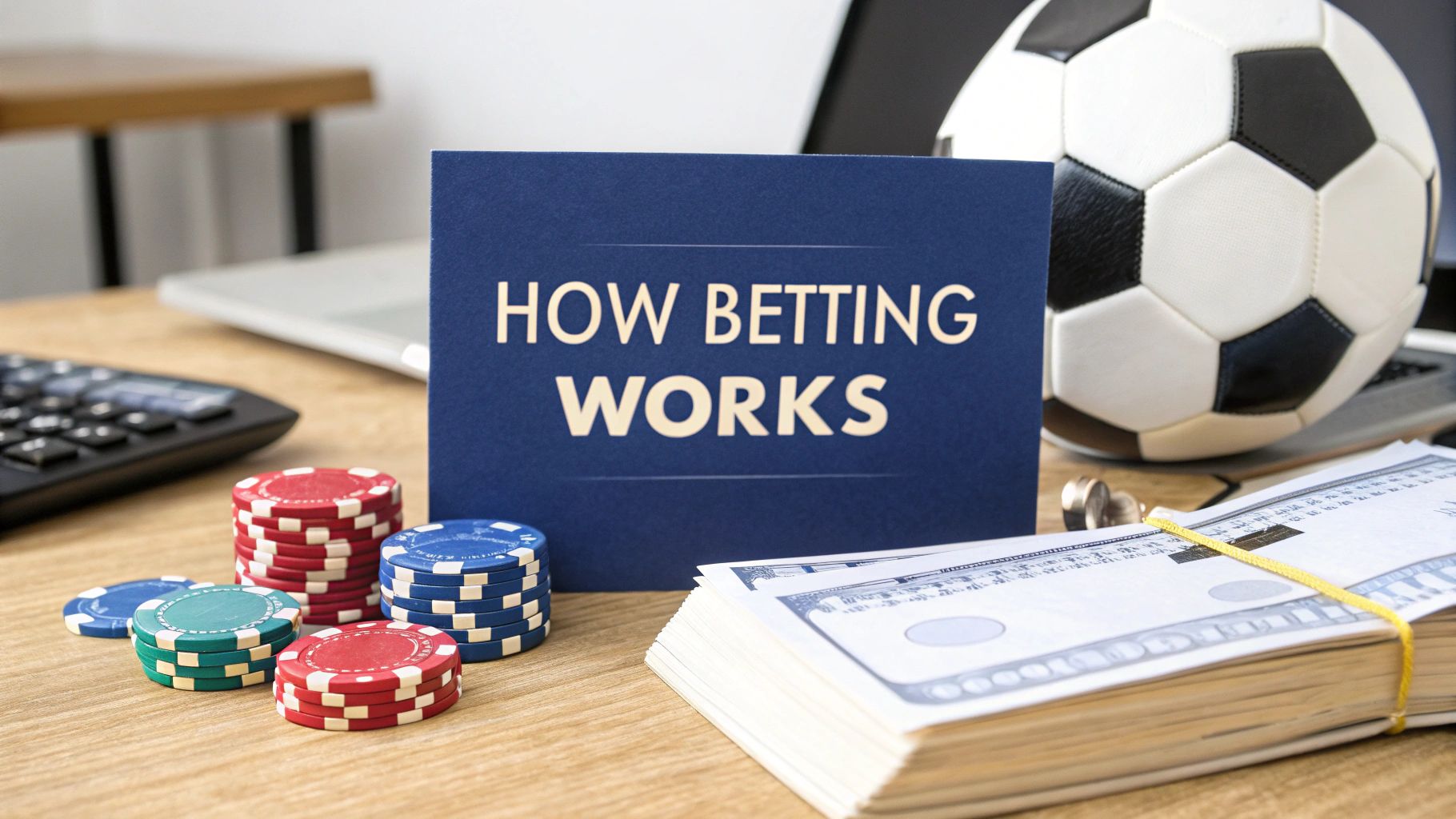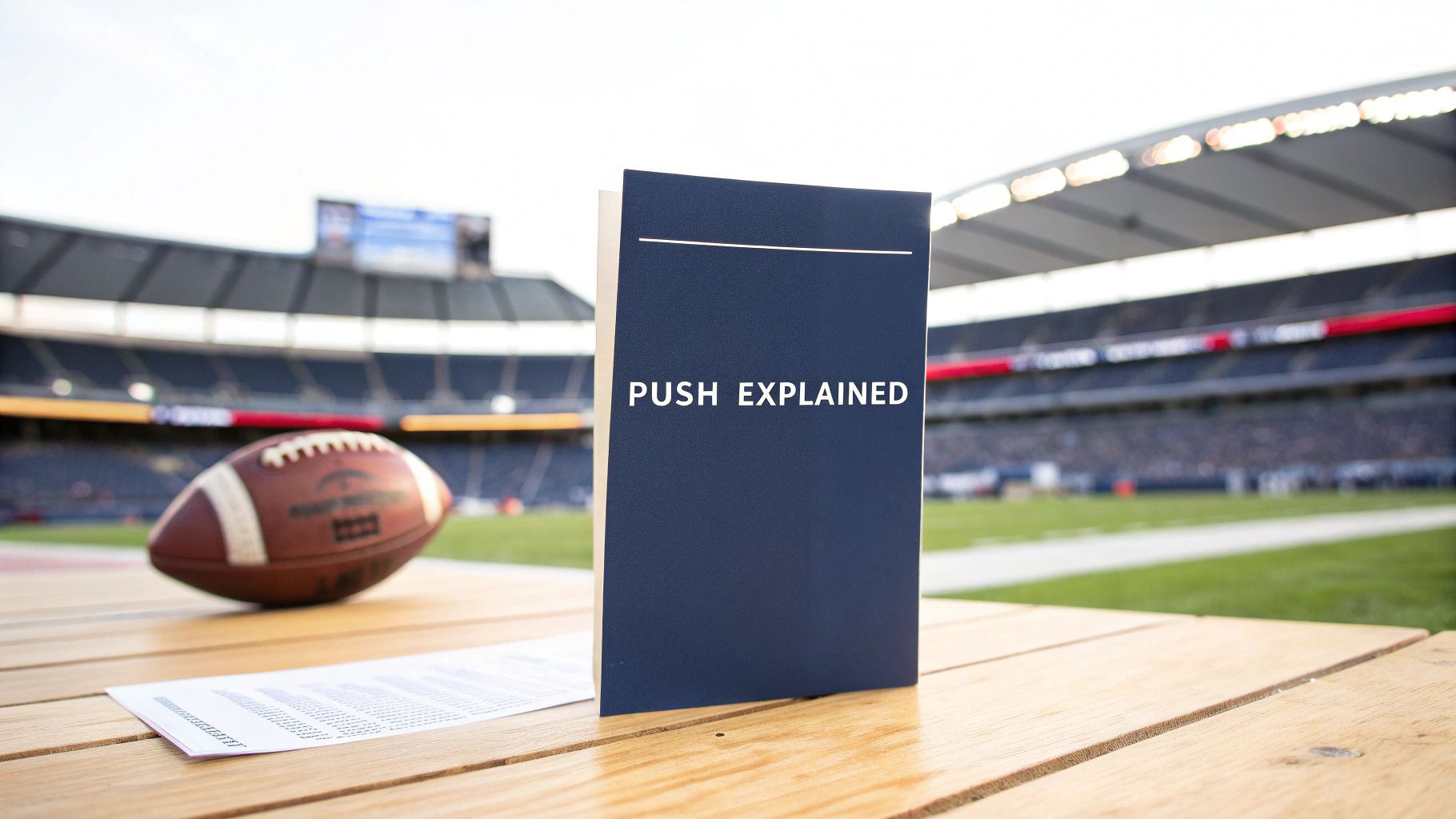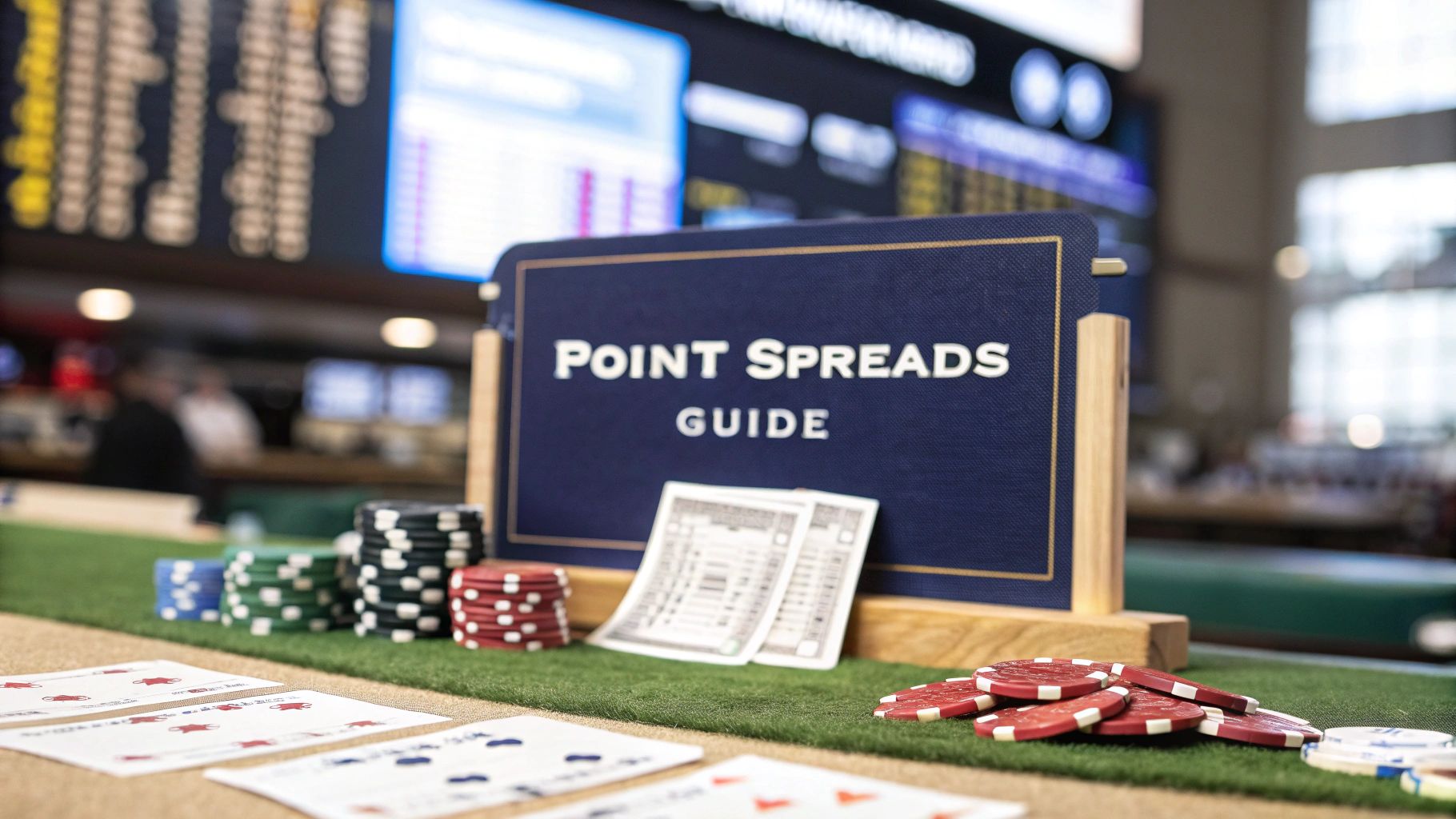
How to Win Football Bets: Proven Tips & Strategies
Learn how to win football bets with our proven tips and strategies. Boost your chances and make smarter bets today!
Let's get one thing straight: winning at football betting has very little to do with luck. It's about building a solid foundation. If you’re serious about this, you need to stop chasing those lottery-style accumulators and start thinking like a strategic investor, not just a casual punter. The real secret lies in a powerful combination of sharp data analysis, iron-clad bankroll discipline, and the trained eye for spotting true value in the odds.
Build Your Foundation for Winning Bets
If you're fed up with torn-up betting slips and genuinely want to learn how to win football bets consistently, the change starts in your head. You have to ditch the gambler's mindset—always hoping for that one massive payday—and embrace the patient, analytical approach of an investor hunting for steady, long-term growth.
This means you have to get comfortable with the idea that wins will often be modest, losses are just part of the game, and your discipline is far more important than a gut feeling.
Profitable betting really boils down to three core pillars that have to work together. If you let even one of them slide, it’s only a matter of time before your whole strategy crumbles, taking your bankroll with it. These are the non-negotiables that separate the pros from the rest of the pack.
The Three Pillars of Betting Success
- Statistical Analysis: Think of this as your attack. It's where you roll up your sleeves and dive into the data—team form, expected goals (xG), head-to-head history, and even situational factors like injuries or manager changes. This is how you form an educated opinion on what’s likely to happen.
- Bankroll Management: This is your defence. It’s a rigid system that dictates exactly how much of your capital you risk on any single bet. A solid plan here means you can ride out the inevitable losing streaks without wiping out your account.
- Value Finding: This is the game-changer. It’s the art of spotting when a bookmaker's odds are more generous than the actual probability of an outcome. Finding this mathematical edge is where the real profit is made.
The infographic below gives a great visual breakdown of how a successful bettor should be allocating their focus.

As you can see, the analysis does the heavy lifting, but protecting your money and finding value are just as critical for any kind of long-term success. This framework is universal, especially in a booming market. Take Romania, for example, where the sports betting market is expected to hit US$256.3 million by 2025, largely thanks to football's immense popularity and the ease of mobile betting. While this growth brings more competition and potentially better odds, the principles for winning don't change one bit. You can actually explore the full sports betting report on Statista.com to get a deeper sense of these market trends.
To help you internalise this shift in mindset, I’ve put together a quick blueprint. Think of this table as your cheat sheet for moving from hopeful gambling to calculated investing.
Your Blueprint for Profitable Betting
| Pillar | Core Principle | Why It's Non-Negotiable |
|---|---|---|
| Data-Driven Analysis | Base every bet on objective data, not emotion or gut feelings. | Emotion leads to bad decisions. Data provides a repeatable, logical foundation for your picks. |
| Strict Bankroll Management | Never risk more than 1-3% of your total bankroll on a single bet. | This is your financial defence. It ensures a losing streak doesn’t knock you out of the game permanently. |
| Value-Centric Approach | Only bet when you believe the odds are better than the true probability. | Profit doesn't come from picking winners; it comes from finding bets where the bookmaker has underestimated the likelihood of an outcome. |
Keep this table handy. When you're tempted to place a risky bet or chase a loss, come back to these pillars. They are the bedrock of any successful betting career.
Success isn’t measured by one big accumulator win but by the steady growth of your bankroll over an entire season. True profitability is a marathon, not a sprint.
Make Data-Driven Betting Decisions
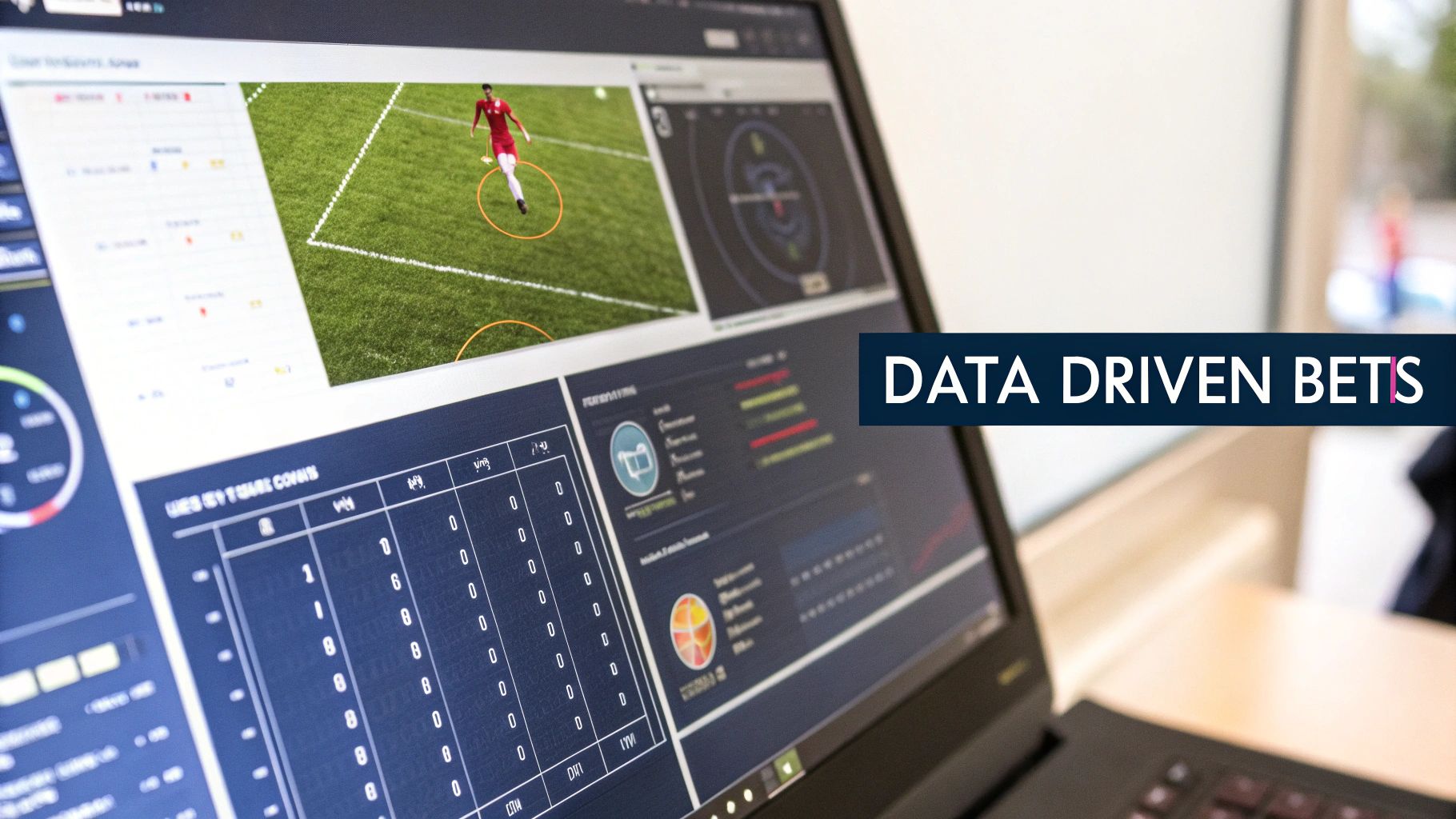
If you're serious about consistently winning football bets, you have to move beyond gut feelings, club loyalty, and a quick glance at the league table. The real edge, the one that separates sharp bettors from the public, is found in the numbers. Data tells the true story of a team's performance—a story often hidden from the casual observer.
This isn’t about just looking at who won their last five matches. It’s about digging deeper to understand how they won. Was it a clinic, with wave after wave of high-quality chances? Or did they just get lucky with a deflected shot and a soft penalty? This is where modern football analytics separate the men from the boys.
Go Beyond Basic Form
Recent results are a starting point, but they can be incredibly misleading. A team might be on a three-game winning streak, but if their underlying metrics show they were fortunate to win each match, a reality check is probably just around the corner. This is where advanced statistics become your secret weapon.
One of the most powerful metrics out there is Expected Goals (xG). This stat cuts through the noise and measures the actual quality of a team's scoring chances. It assigns a probability to every shot based on its location, the type of pass that set it up, and other key factors.
A team that’s constantly scoring more than their xG suggests is likely riding a hot streak that won't last. On the flip side, a team underperforming their xG could be a sleeping giant—creating plenty of great chances but just failing to find the back of the net. Sooner or later, they will.
By focusing on performance data like xG rather than just results, you can spot teams that are statistically stronger or weaker than their current league position suggests. This is a massive advantage over the average bettor.
Key Metrics for a Sharper Edge
To build a complete picture, you need to look at a cluster of stats, not just one. Combining these data points helps you form a much more reliable prediction of how a match might play out.
- Shots on Target (SoT): Forget raw shot counts; they're full of noise. Shots on target give you a clearer idea of a team's attacking threat and finishing ability.
- Head-to-Head (H2H) Records: History often repeats itself. Look for patterns in recent meetings. Does one team consistently dominate another, regardless of form? Are there tactical matchups that one side just seems to exploit every time?
- Defensive Stability: It's not all about attack. Metrics like shots conceded per game and clean sheet percentages are vital. A high-flying attacking team can easily be undone by a leaky defence.
Applying Data to Local Leagues
This data-driven approach is especially powerful when you apply it to specific leagues where unique trends emerge. Take Romania's Liga I, for example. Anyone relying on a simple home-advantage bias here would be throwing money away.
An analysis of the 2025/2026 season shows a surprisingly balanced win-draw-loss split: 37% home wins, 35% draws, and 28% away wins. That incredibly high frequency of draws (35%) screams that markets like "Draw No Bet" or even backing the draw itself can offer fantastic value.
Furthermore, the over/under 2.5 goals market is almost a coin flip, with 52% of games going under. These stats paint a clear picture: successful strategies in this league often involve betting on tight, low-scoring games and a high chance of a stalemate. To really get into the weeds on this, you can explore the full breakdown of Romania Liga I betting statistics.
This is the essence of making data-driven decisions: turning raw numbers into a tactical advantage. The table below shows you how to shift your focus from superficial stats to ones that give you a real predictive edge.
Comparing Stats for a Sharper Edge
| Metric | What It Really Tells You | How to Use It for Betting |
|---|---|---|
| League Position | A historical summary of a team's past results. | A decent starting point, but it can easily hide underlying performance issues or strengths. |
| Expected Goals (xG) | The quality and quantity of scoring chances a team creates and concedes. | Your go-to for identifying teams that are overperforming or underperforming. This is where you find value. |
| Recent Win/Loss Streak | Short-term momentum, which can be driven by luck or genuine quality. | Always check it against xG. This tells you if the streak is sustainable or if a team is due for a fall. |
| Shots on Target Ratio | A team's efficiency in turning attacks into genuine threats on goal. | Helps separate teams that just pepper the goal from distance from those that are clinical and create clear-cut chances. |
By building your analysis around these more insightful metrics, you arm yourself with the tools to see what other bettors miss. This analytical depth is a cornerstone of any strategy designed to win at football betting over the long run. It's not about having a crystal ball; it's about making a more informed guess than the bookmaker.
Master the Art of Finding Value Bets
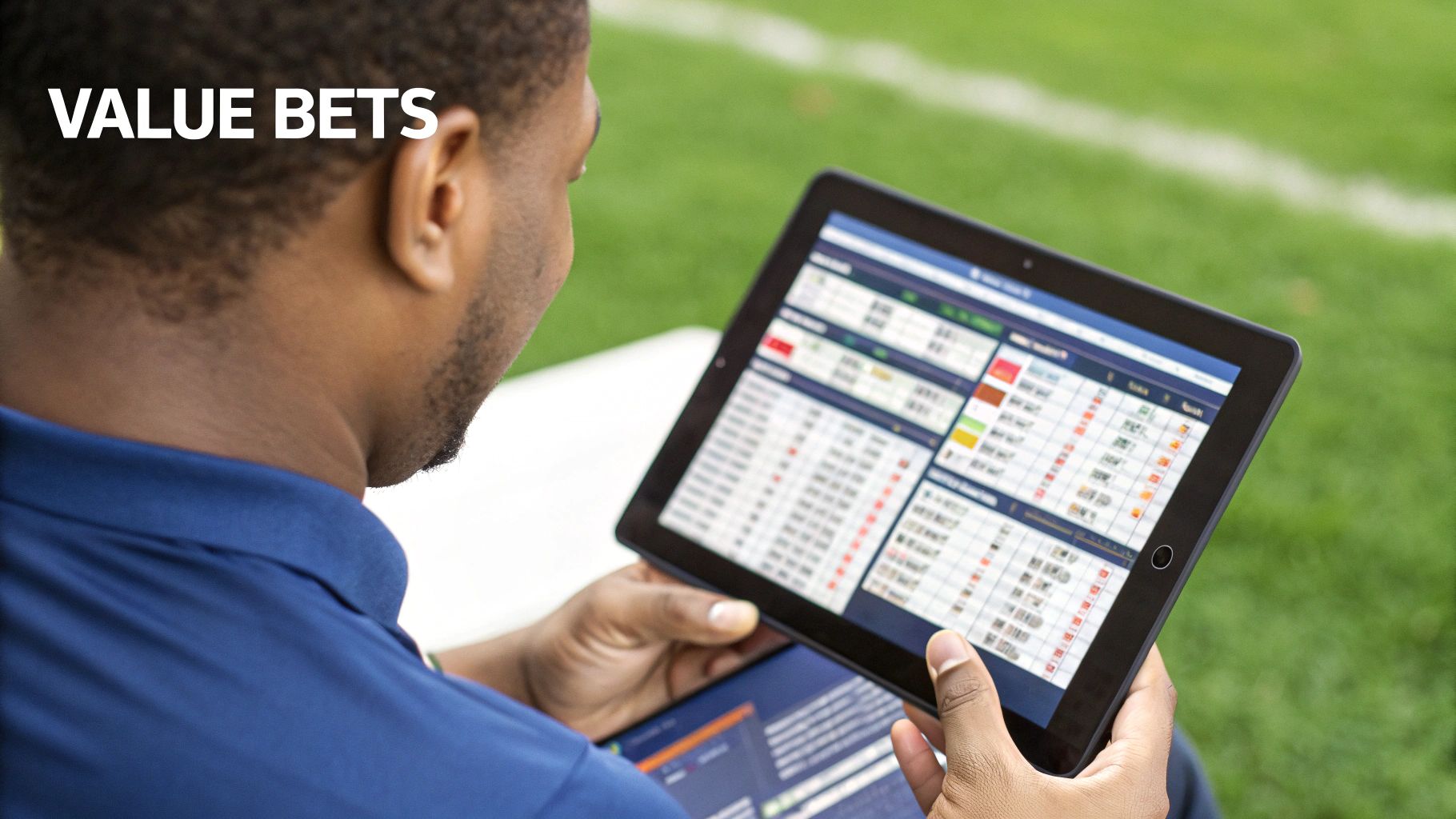 If there’s one skill that truly separates the consistently profitable bettors from everyone else, this is it. Learning how to spot value is, without a doubt, the most important factor in your long-term success. It’s a concept most casual punters get wrong, but it’s the absolute heart of how you can win at football betting for years to come.
If there’s one skill that truly separates the consistently profitable bettors from everyone else, this is it. Learning how to spot value is, without a doubt, the most important factor in your long-term success. It’s a concept most casual punters get wrong, but it’s the absolute heart of how you can win at football betting for years to come.
Winning isn't about picking the team you think will win. The real game is finding moments when the odds offered by a bookmaker are better than the actual statistical probability of that result happening. You’re essentially hunting for mispriced assets in the market.
Think of it like this: you know a specific pair of trainers normally costs 500 RON. One day, you see them in a shop for 350 RON. You've found value. You grab them not just because you need new shoes, but because the price is simply too good to ignore. That’s the exact same logic we’re applying to football odds.
Understanding Implied Probability
Every price a bookie sets has an "implied probability" baked into it—their estimation of how likely an outcome is. Working this out is your first step to spotting value, and the formula couldn't be simpler:
Implied Probability (%) = (1 / Decimal Odds) x 100
For example, if a team has odds of 2.50 to win, the implied probability is 40% (1 / 2.50 = 0.40). The bookmaker is effectively telling you they think this team has a 40% chance of winning. This figure is your new baseline.
Your job is to take that number and challenge it. Use your own analysis—the data-driven approach we talked about earlier—to decide if you agree with that 40%. If your homework suggests their real chance of winning is closer to 50%, congratulations. You’ve just found a value bet. The odds aren't telling the full story.
A Practical Value Bet Scenario
Let's make this real with an example from Romania's Liga I.
Imagine CFR Cluj are playing away against FC U Craiova 1948. The bookmaker is offering odds of 2.20 for a Cluj victory.
- Calculate Implied Probability: First, we do the maths: (1 / 2.20) x 100 = 45.5%. The bookie has priced Cluj’s chances at just over 45 in 100.
- Do Your Own Homework: Now you dig in. You discover that Craiova are missing their top goalscorer and a key central defender through suspension. On top of that, Cluj boasts the league's best away record and has beaten Craiova in their last three meetings without conceding a single goal.
- Estimate Your Own Probability: Taking everything into account, you reckon Cluj's true probability of winning is actually around 55%.
- Spot the Value: Your assessment (55%) is significantly higher than the bookmaker’s implied probability (45.5%). This is a textbook value bet.
The objective isn't to be right every single time. It's to consistently place wagers where the mathematical odds are tilted in your favour. Over hundreds of bets, this edge is precisely what builds a healthy bankroll.
This approach fundamentally shifts how you see betting. You stop asking, "Who's going to win?" and start asking, "Do these odds offer good value?" If you want to get deeper into this, you can learn more about how to identify value bets and track odds movement in our detailed guide.
Remember, a heavy favourite at 1.30 might be extremely likely to win, but the price itself could offer zero value. On the flip side, an underdog at 5.00 might be a long shot, but if your analysis suggests their true chances are better than the 20% implied probability, it could be a fantastic value bet. Winning at this game is all about making smarter investments, not just picking winners.
Implement Disciplined Bankroll Management
Let's get one thing straight. You could have a crystal ball that predicts football matches, but without a rock-solid bankroll strategy, you will go broke. That isn’t hyperbole; it’s a mathematical certainty.
Disciplined bankroll management is the single biggest difference between a professional bettor and a weekend punter. It's the defensive wall that protects you from yourself and from the inevitable swings of fortune, keeping you in the game long enough for your edge to actually make you money.
The entire philosophy boils down to one rule: protect your capital at all costs. Football betting is full of variance—a polite term for brutal, soul-crushing losing streaks that happen to everyone. Your bankroll strategy is what lets you ride out those storms without panicking, chasing losses, or blowing up your account.
Defining Your Bankroll and Unit Size
First things first, you need to set your bankroll. This is a pot of money put aside only for betting. Crucially, it must be an amount you are completely comfortable losing. If losing this money would affect your ability to pay bills or buy groceries, it’s too much. Treat it like starting capital for a business.
With your bankroll defined, you can figure out your unit size. A unit is simply a percentage of your total bankroll, usually somewhere between 1% and 3%. This standardises your stake for every single bet, taking emotion completely out of the decision.
For example, with a 2,500 RON bankroll, a 1% unit is 25 RON. That becomes your standard bet.
Bankroll management is your insurance policy against bad luck. It ensures that a string of unfortunate results doesn't wipe you out before your skill has a chance to shine through.
This approach builds consistency. It stops you from getting greedy after a big win and, more importantly, it stops you from trying to win it all back with one huge, desperate bet after a loss. To really nail this down, take a look at our guide on the importance of tracking units won and lost in sports betting. It's a non-negotiable part of professional betting.
Choosing Your Staking Method
Most serious bettors fall into one of two camps when it comes to staking. Both work well, but they cater to different personalities and risk appetites.
- Level Staking: This is the easiest and most common way to do it. You bet the exact same amount—one unit—on every single wager. It doesn't matter if you love the bet or just like it, the stake is the same. It’s a conservative approach that keeps variance to a minimum.
- Percentage Staking: Here, your stake is always a set percentage of your current bankroll. So, when you win, your bankroll grows and your next bet is slightly larger. When you lose, your bankroll shrinks, and so does your next bet. This can accelerate growth but also requires you to recalculate your stake constantly.
Let's see how they compare with a 2,500 RON bankroll and a 2% unit (50 RON):
| Staking Method | After a 50 RON Win | After a 50 RON Loss |
|---|---|---|
| Level Staking | Next stake is still 50 RON. | Next stake is still 50 RON. |
| Percentage Staking | Bankroll becomes 2,550 RON. Next stake is 51 RON (2% of 2,550). | Bankroll becomes 2,450 RON. Next stake is 49 RON (2% of 2,450). |
If you're just starting out, I can't recommend level staking enough. It's simple, robust, and lets you focus on finding good bets.
Whichever path you choose, the key is unwavering discipline. Stick to your plan, trust the numbers, and never, ever let a gut feeling or a bad run of luck dictate how much you stake. This is how you survive and ultimately thrive in football betting.
Look Beyond the Numbers: Analysing Team Form and Situational Factors

Stats like Expected Goals (xG) are fantastic tools, no doubt. They give you a solid, objective look at a team's performance. But if you're only looking at a spreadsheet, you're missing half the story—the human half. To really get an edge, you have to dig into the real-world factors that can flip a match completely on its head.
Think of it this way: the numbers tell you what happened, but the situational context tells you why. A team can have incredible underlying data but still crumble under the pressure of low morale, a congested schedule, or a key injury that the stats haven't caught up with yet. This is where your gut and your expertise come into play, blending hard data with smart observation.
Dig Deeper Than a Simple Win/Loss Record
Seeing a team on a five-game winning streak looks impressive, but you need to ask why they're winning. Was it a string of easy home games? Or maybe they’ve just appointed a new manager, and the classic "new manager bounce" is in full effect, injecting fresh energy that a data model might be slow to recognise.
On the flip side, you might see a top-four contender scraping by with narrow wins. A quick search could reveal dressing room unrest or rumours that the manager has lost the players' confidence. That’s a massive red flag that the simple results won't show you.
The fixture list is another goldmine of information. Let's say a top side is playing a mid-table team. The odds look skewed, but is this their third game in just seven days? Are they resting their star striker for a massive Champions League tie next week? Fixture congestion is a killer. It leads to fatigue and squad rotation, creating the perfect storm for an upset that most casual punters will completely miss.
Layering this kind of real-world context over raw data is what separates a good bettor from a great one. You stop just reading stats and start understanding the story of a football club.
The Real Power of Momentum and Atmosphere
Momentum is a very real, tangible force in football. A winning streak builds an almost unstoppable confidence, while a losing spell can create a downward spiral of doubt and sloppy mistakes. You can often find fantastic value by getting on these streaks at the right time.
Take the Romanian Liga I during the 2024-2025 season. FCSB went on a remarkable 13-game unbeaten streak. At the other end of the table, Politehnica Iasi suffered through a miserable 13-game winless run. Backing FCSB during their hot streak, or strategically betting against Iasi during their slump, was a simple but highly profitable strategy. You can see these patterns for yourself by checking out the team performance data from that season on ESPN.
The atmosphere on match day matters, too. That same season, the derby between Dinamo Bucuresti and FCSB drew a crowd of 45,469 spectators—a cauldron of noise and pressure. Contrast that with a match involving Unirea Slobozia that pulled in just 121 fans. A roaring home crowd really can be the "12th man," influencing referees and giving the home side a psychological boost. It’s a factor you ignore at your peril.
Your Pre-Bet Situational Checklist
Before you ever click "place bet," run through this quick mental checklist. These are the qualitative factors that can either confirm your analysis or serve as a final warning to stay away.
- Key Injuries and Suspensions: Who is missing? Don't just look at the number of players out; focus on the key players. The absence of a star goalscorer, a commanding centre-back, or the main creative midfielder can completely change how a team plays.
- Team Morale: Scan the news, player interviews, and even social media. Does the team sound united and confident, or are there whispers of arguments and conflict?
- Fixture Importance: How much does this game really matter to each team? A club fighting to avoid relegation will give everything, while a mid-table side with nothing to play for at the end of the season might already be thinking about their summer holidays.
- Tactical Matchups: How do their styles clash? A slow, possession-based team can be a sitting duck for an opponent that loves to press high and attack with pace. Understanding these mismatches is crucial, which is why we've put together a full guide on how to conduct a proper tactical matchup analysis for betting.
Consistently weighing these factors adds a rich, powerful layer to your betting process. It helps you spot the opportunities—and the traps—that the raw numbers alone will never show you, giving you a serious long-term advantage.
Got Questions? Let's Get Them Answered
Taking the leap from casual weekend punts to a more serious, calculated strategy is a big deal. It’s totally normal to have questions swirling around as you start to get your head around the numbers. Here are some of the most common things people ask when they decide it’s time to start betting smarter, not harder.
So, How Much Do I Really Need to Start?
Honestly, you don't need a massive pot of gold. The real game-changer isn't the size of your starting kitty, but the discipline you bring to managing it. Your initial bankroll should be an amount you are genuinely comfortable losing—whether that's 500 RON or 2,500 RON.
Here’s the golden rule: only ever stake a tiny fraction of your total bankroll on any single bet. We’re talking 1-2%. If you’re working with a 1,000 RON bankroll, your standard bet should be just 10-20 RON. This simple rule is your armour. It protects you from wiping out during a bad run (and trust me, they happen to everyone) and gives your edge the time it needs to come good over the long haul.
Are Singles Genuinely Better Than Accas?
For building a profit over time, single bets are light years ahead. It's not even a competition. Accumulators, or 'accas', get all the attention because they promise that one massive, life-changing win from a tiny stake. But in reality, they are a bookmaker's best friend.
Every single leg you add to an accumulator multiplies the bookie's built-in profit margin. A four-fold accumulator doesn't just quadruple your potential win; it also quadruples the mathematical advantage the bookie holds over you.
Think of accumulators as lottery tickets. They're a bit of fun, but they are not a serious investment strategy. Your actual plan for winning at football betting should be built almost entirely on finding value in single wagers.
How Can I Be Sure I've Found a "Value Bet"?
A value bet is simply a situation where your own analysis tells you an outcome is more likely to happen than the odds suggest. Spotting one is a pretty straightforward, two-step process.
First, you have to translate the bookie's decimal odds into what's called an implied probability. The formula couldn't be simpler:
(1 / decimal odds) * 100
So, if you see a team priced at odds of 2.50 to win, the bookmaker is basically saying they have a 40% chance of winning that match (because 1 / 2.50 = 0.40).
Now comes the second part—this is where your skill and hard work pay off. Using your own research into things like team form, injuries, and how the teams match up tactically, you come up with your own probability. If your homework leads you to believe the team actually has a 50% chance of winning, you've just found yourself a value bet. Your probability (50%) is higher than the bookie's (40%), which means the odds are tilted in your favour. The entire game is about getting this assessment right more often than the market.
Putting all this knowledge into action to find consistent winners takes time and serious number-crunching. That’s where OddsHaven steps in. Its AI does the heavy lifting, analysing thousands of data points every day to flag up high-confidence picks and parlay suggestions. It’s time to stop guessing and start making decisions backed by solid data. See how it works by visiting https://www.oddshaven.ai today.
Ready to Start Winning?
Join OddsHaven and get instant access to AI-powered predictions with an 87% win rate on high-confidence picks
Try OddsHaven Free for 5 Days